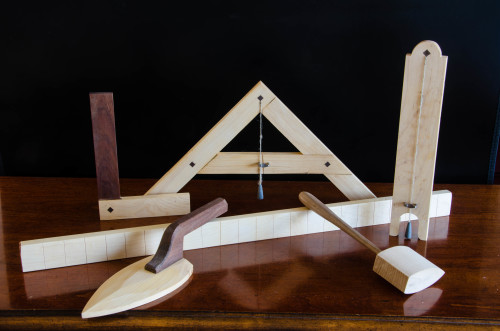Becoming a Freemason is a lifelong study in learning to become a better man. It requires commitment, careful consideration, and daily mindfulness to live the fraternity’s values each day. Freemasonry is structured around symbols and lessons derived from the medieval stonemasons, intended to arm each Brother with the knowledge to build themselves into a man of integrity. The core theme Grand Master Richard A. Dickerscheid instilled within Ohio Freemasonry this year is “Use the Tools,” a call for Brethren to use both physical and metaphorical tools to improve both their individual life and their communities. The below physical Masonic working tools not only hold practical power, but meaningful symbolism that Masons must carry through their everyday practice.
A prospective Freemason must complete three lessons called degrees before fully entering the brotherhood and becoming a Master Mason. When a man embarks on his Masonic journey, he is unformed, rough, and lacks the knowledge of an expert craftsman. At each degree, he learns more about Freemasonry, how to be a good man, and understand the Supreme Architect’s design.

Entered Apprentice
The first stage of becoming a Freemason is completing the first degree of the Entered Apprentice. In this degree, the candidate is inexperienced and lacking knowledge of the craft, like the rough stone from the quarry that needs to be shaped and polished before it can be used in the building. He is handed a common gavel, the tool workmen use to shape the stone or rough ashlar, and instructed that it is one of the working tools of the Entered Apprentice. He is challenged to strike off the vices and distractions in his life which may lead him astray, away from what is truly important to living a meaningful and satisfying life.
The twenty-four-inch gauge represents time and is one of the first lessons for the initiate. He learns that we must use our time well, and he is instructed to divide the day into three parts with time for God, our neighbors, and ourselves. Exercising self control, making good decisions, taking action, understanding and fulfilling our duties whether as employees, husbands, fathers, or believers are all addressed by implication in the management of time.
Fellow Craft
In completing the second degree, an initiate advances to the skilled craftsman or Fellow Craft. In doing so, he can test the work of the Entered Apprentice and use his skill to improve their Rough Ashlar into the Perfect Ashlar for use in the master’s plan.
The tools of this degree consist of the square, level, and plumb. The square teaches a Fellow Craft to ensure they are right and just in their actions. It is among the most essential tools in Freemasonry, serving as a daily reminder for Masons on how to live their lives and treat others. For a more detailed description of the meaning behind the square, please read our blog on The Square and Compasses. The level represents equality, teaching that all Freemasons are equal, share in one goal, and receive God’s same judgment. The plumb is the tool of integrity, teaching a Mason the virtues of being just, honest, and upright through actions big and small. This degree cements a Mason’s commitment to the core values of brotherly love, relief, and truth.
Master Mason
By the third degree, the Master Mason has learned to use all the tools of his craft to fulfill the plans of the Divine Artist, and he is then introduced to the trowel. The trowel is used by stonemasons to spread the cement that binds the stones of the building into one common structure. What binds men together?
Masons are bound together by certain common values and experiences. They share the knowledge they have learned in their progress through the three degrees, and their lives are thereby improved in physical, moral, and spiritual ways. They are united by brotherly love and friendship.Great ideas enrich the mind and common experiences inspire the spirit, but it is the warm camaraderie and fellowship that draws men together and opens the door to friendships that last a lifetime. Thus, it is fitting that the final working tool presented to the Master Mason is the trowel to spread the cement of Brotherly Love and Friendship.
Brethren, we would love to hear your stories on what “Using the Tools” means to you, and which Masonic working tools you use most often in the craft. Please share them with us on our Facebook or Twitter pages at @GrandLodgeOhio.
Looking to explore the history behind more common Masonic symbols? We invite you to read our educational blogs on Masonic Coins, Operative vs. Speculative Masons, and the Cornerstone.